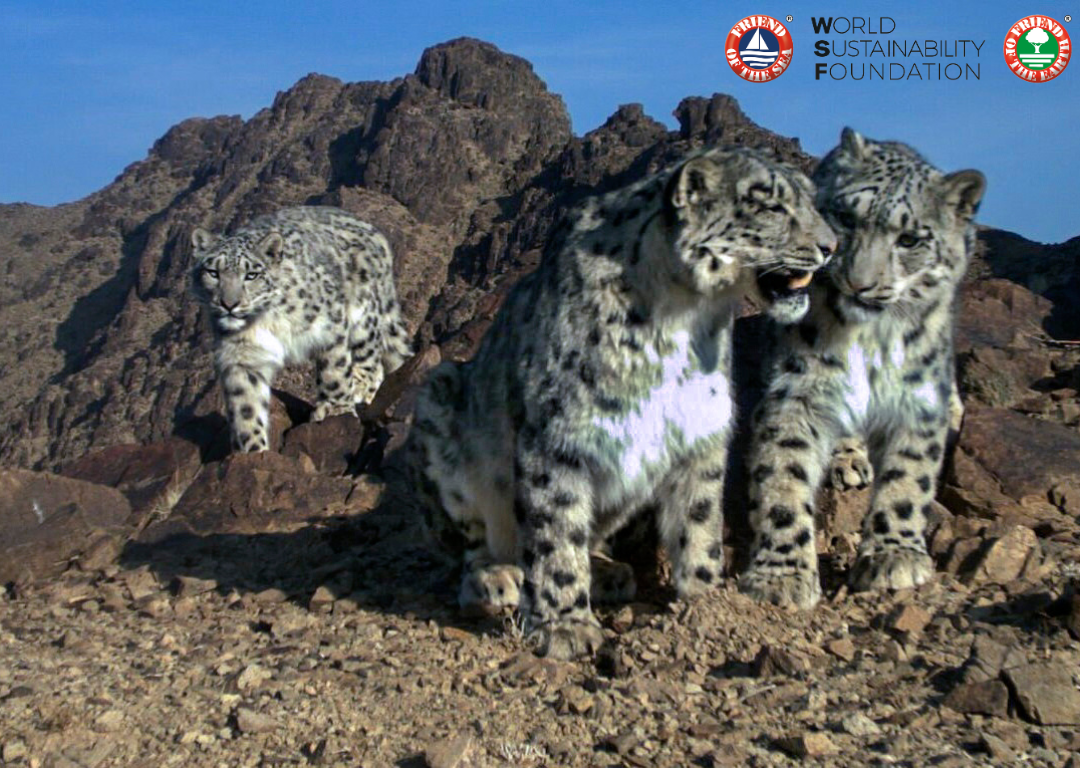On October 23rd the Snow Leopard Day celebrates this endangered cat, and here’s all you need to know about the also known Panthera Uncia, or Ounce.
The Snow Leopard is a large cat common to the mountain ranges of Asia. With whitish-grey fur with black spots on the head and neck, rosettes on the back and flanks, and its characteristic bushy tail that ends in a blackish tone, the Snow Leopard is the smallest member of the genus Panthera, reaching up to 150 cm from head to body and 105 cm of tail.
These animals live in cold temperatures and high altitudes, being rarely seen by men in the wild. They are solitary and crepuscular animals, and can be mostly found around cliffs and ridges that provide shade and hiding places, strategic when comes to hunting. Like cats, they leave scent marks with urine and glandules located on their face to indicate territories and travel routes.
Eating Habits
Snow Leopards are carnivores, and wild sheep and goat are their favourite preys, such as the Himalayan blue sheep (Pseudois nayaur), the argali (Ovis ammon), and the markhor (Capra falconeri), but will also predate cattle, small mammals like pika and vole (lagomorphs and rodents), wild boar, deer, and some monkeys. They prefer prey weight from 36 to 76 kg, according to studies, but will hunt anything depending on available prey.
To reach their prey, Snow Leopards will spring up/down mountainsides up to 300 meters. After a successful hunt, they will drag the prey to a safer place to avoid competition with vultures and other carnivores, and enjoy their meal peacefully.
Reproduction
Snow leopards used to mate at the beginning of winter to guarantee that the offspring would be born in late winter/spring (easier seasons to find food), a season marked by an increase in making and calling. With a remarkably small period of fertility, only 5 to 8 days, males prefer to mate with only one female, mating from 12 to 36 times a day. The gestation period of roughly 90/100 days will result with up to 3 cubs being born. Females give birth in crevices with nests made from their fur; the kittens are born blind, weighing from 300 to 500 grams, they will only walk at 5 weeks old, and will leave the security of the maternity at roughly 2 to 4 months old.
Kittens will part ways with their mothers around 20/21 months, around the same time they will be sexually mature, but the mother and children will encounter with each other for a few days for a period of 4/7 months.
They normally live for 15/18 years in the wild and around 25 in captivity. Snow Leopards have a generational life of 8 years, meaning they can mate and generate cubs for that period only.
Where?
Snow Leopards inhabit South and East Asia in the Tibet and Yunnan Regions across 12 countries: Afghanistan, Bhutan, China, India, Kazakhstan, Kyrgyz Republic, Mongolia, Nepal, Pakistan, Russia, Tajikistan, and Uzbekistan. In rocky areas, forests, shrubland, and grassland in high mountains with cold and temperate weather.
Threats
Snow Leopards has been listed as threatened with extinction since 1985.
The major threat, aside from loss of habitat and prey due to Global Warming and human expansion, is poaching and illegal trade of fur and body parts. Their meat is used in traditional Tibetan medicine which is believed, without scientific evidence, to cure kidney problems. Bones are used in Chinese and Mongolian medicine, as it is also believed, with no scientific support, that they cure rheumatisms, injuries, and the aches of bones and tendons.
Their fur is used in traditional clothing in Tibet and Mongolia, as décor and as hunting trophies. As it can prey on cattle, it can also be killed in human-wildlife conflict.
Fun Facts
· The Snow Leopard fur is very thick to protect it from the cold, the fur can be 5 to 12cm long.
· Its canine teeth are approximately 29mm long.
· Snow Leopards have large nasal openings, to allow an increase in the air volume inhaled, an adaptation to the low oxygen levels in high altitudes.
· Snow Leopards have large paws to distribute better the body weight, which helps to not sink in the snow. The paws also have dense fur between the undersides and cushions, to lower the heat loss.
· Snow Leopards can walk up to 7km every night, and up to 10 individuals inhabit an area of 100 km2.
· It can move in 85 cm (33 in) deep snow but prefers to use existing trails made by other animals.
· In Nepal, they have been legally protected since 1973, with penalties of 5–15 years in prison and a fine for poaching and trading them.
· They can survive on a single Himalayan blue sheep for two weeks before hunting again.
The World Sustainability Foundation’s Friend of the Earth project provides financial support for the Snow Leopard Trust (SLT), the only organization dedicated to snow leopard species conservation in 5 key countries in Asia. Its habitat coincides with a mountainous and rocky territory, impervious for researchers to explore and protect.
By raising funds and awareness, WSF is also helping the SLT in supporting several initiatives focused on snow leopard monitoring, local community development, and anti-poaching unit training. WSF’s collaboration will allow SLT to put two camera traps on Mongolian mountains in order to obtain more behavioral, ecological, and relational information about the local population, update the statistics and learn more about this “ghost cat”.
Choose Friend of the Earth certified products from sustainable agriculture, promote awareness and fund selected onsite projects to protect endangered big cats.




